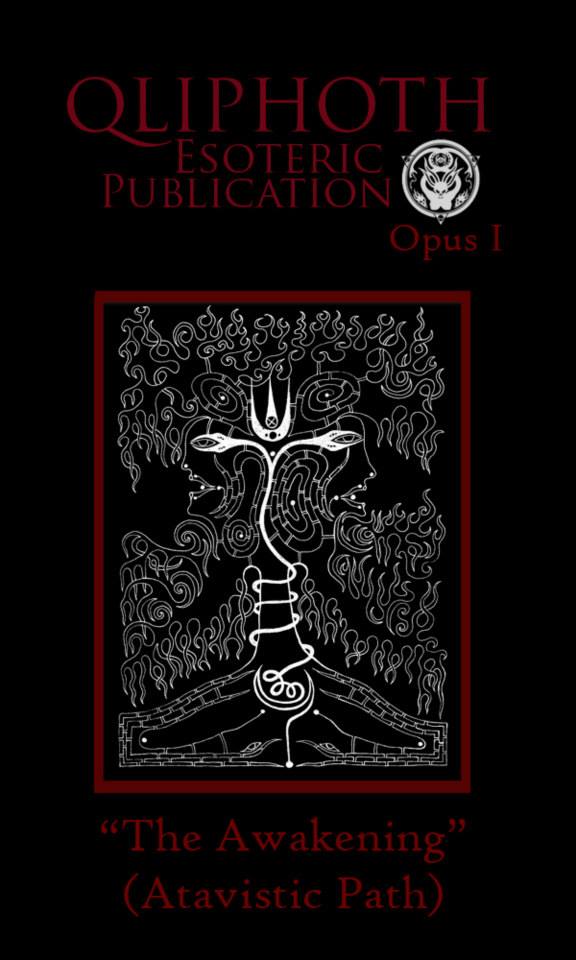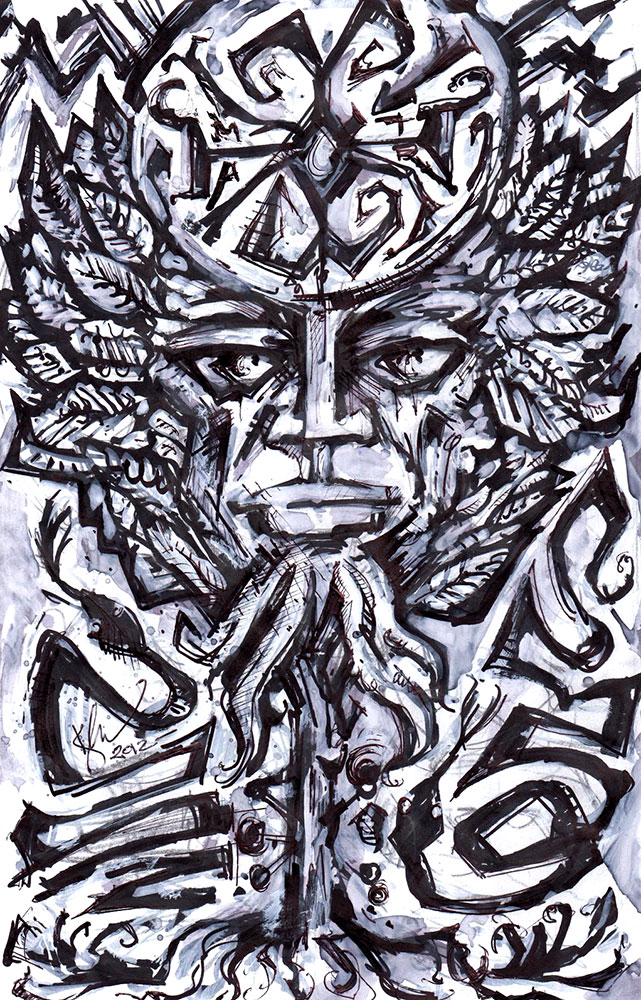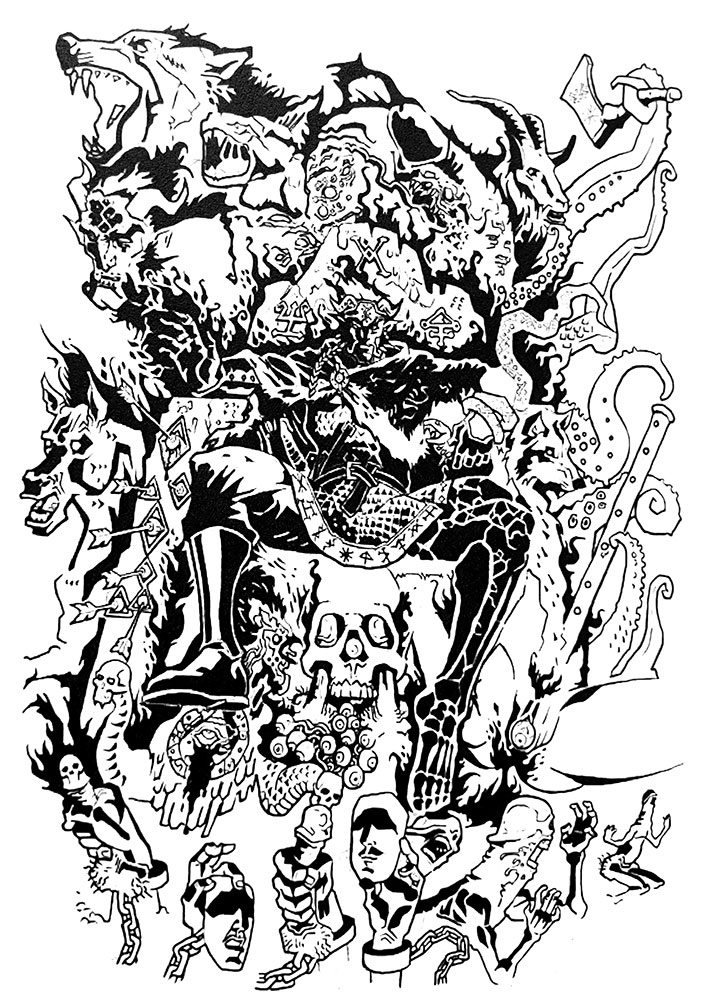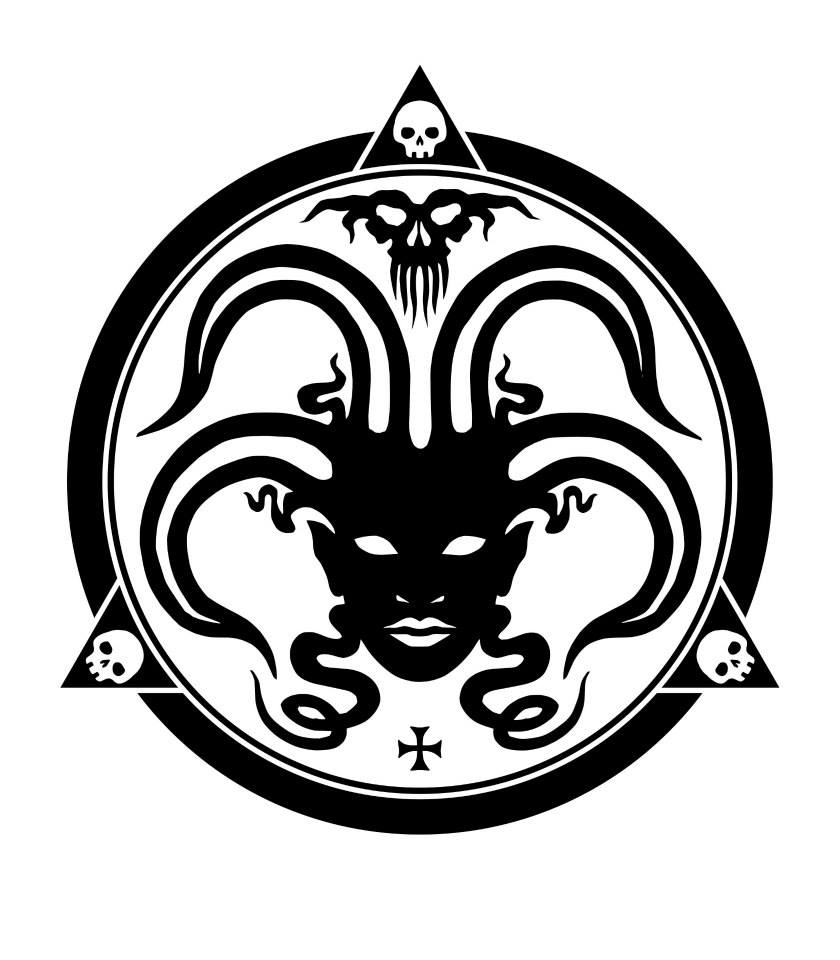 Released in 2012, Qliphoth Esoteric Publication Opus 1 is arguably one of the first journals in the current glut of darkly-hued occult publishing. Edited by Edgar Kerval and here published by Aeon Sophia Press, Qliphoth would have something of an itinerant life, moving betwixt publishing houses. A second volume would be released in a more conventional occult-book format by Aeon Sophia Press, before Nephilim Press took up the mantle for a time, with still later volumes being released by Kerval’s own publishing imprint.
Released in 2012, Qliphoth Esoteric Publication Opus 1 is arguably one of the first journals in the current glut of darkly-hued occult publishing. Edited by Edgar Kerval and here published by Aeon Sophia Press, Qliphoth would have something of an itinerant life, moving betwixt publishing houses. A second volume would be released in a more conventional occult-book format by Aeon Sophia Press, before Nephilim Press took up the mantle for a time, with still later volumes being released by Kerval’s own publishing imprint.
There is a wide range of both contributors and topics in this first volume, embracing themes of the nightside, voudon, hoodoo, general sorcery and even a little bit of syncretisation of Loki with Azatoth (by which is meant HP Lovecraft’s Azathoth, not the similarly h-deficient Swedish black/death metal band from Uddevalla, or, for that matter, the death metal band from Stockholm – Satan bless you, Encyclopaedia Metallum). From the contributors, there’s a few new names as well as some familiar ones, such as Sean Woodward, Kyle Fite, Aion 131 (whose poem Tua-Set is an excerpt from his Liber Phoenix), Orryelle Defenestrate Bascule (with their nightside notes, some of which also appeared in Anathema’s Pillars journal), and Nicholaj de Mattos Frisvold (in a lengthy piece on antinomian sorcery).
Amongst many of the contributions there’s a palpable sense of a giddy delight in darkness and shadow, of a youthful enthusiasm for what the authors hope is transgressive and original, but which old timers might find either sweet or irritating. This is particularly exacerbated by the perhaps unwise inclusion of author photos in some pieces. Formatted into their respective essay as if they’re an integral illustration, fingers contorted into significant gestures, their fresh faces glare out at the reader as if to say “Occultism, it’z serious bidness.” Bless.
The earnestness may account for the roughness in some of the writing, all pleonastic phrasing and reckless disregard for proofing. The consistently spellcheck-averse Daemon Barzai opens a piece on Gamaliel (presumably the qlipha and not the first century leader of the Sanhedrin, but he doesn’t say) by referring to it as the dark side of the moon and redundantly describing it as having an intimate relationship with, wait for it, “the dark side of the moon,” – that is very intimate, onanistically so. What follows are a series of guided meditations in which naked beautiful ladies are only outnumbered by the comedic triumphs of muddled and cruelly unedited English: “Opposite you appeared Lilith. Her body is naked but it is difficult to see her face. Her hairs are red as fire.” So, how many hairs? I’m thinking just two or three for pure comedy gold. “Come a dark mist and go out three black dogs that to be with a woman that wearing a black dress, she has a crown with jewels. His presence commands respect.” Yes, I imagine it does.
There’s other questionable writing, such as The Science of Magic by S. Ben Qayin, although saying that it’s written by him is a bit of stretch. Incapable of paraphrasing, he quotes extensively from a few sources, with some of the quotes running to as much as half a page. As these are not formatted any differently from the main body, the reader will assume that Qayin has written a lengthy, erudite piece, but his own writing only occurs as smatterings between these verbatim quotes, poorly tying completely unrelated themes together with logical fallacies. This approach reaches its surreally ridiculous zenith when he quotes himself in order to promote his Volubilis ex Chaosium book; one wonders how many pages of quotes that must contain.
But these failures are not necessarily the rule and there are a few diamonds amongst the rough, mainly coming from the more grizzled of the contributors. Sean Woodward uses a, one assumes, fictional narrative in a meditation on the Hoo Queen, with the narrator exploring the coastal town of Blackmouth in search of this Shadow Queen of Sirius. Though it lacks much in the way of cosmic horror (though there is a sense of the cosmos), there’s an unavoidable sense of Lovecraft here, with the lone narrator, a stranger in a strange town, visiting a place whose name alone is redolent of Lovecraft’s Innsmouth. There’s a similar focus of hoodoo from a name as familiar as that of Sean Woodward, Kyle Fite, who in the past has pursued the fictional narrative as occult lesson, but here has a more straight forward essay. Like Woodward’s contribution, Becoming Hoodoo is very much in the shadow of Michael Bertiaux, discussing the first section of The Voudon Gnostic Workbook, and its guide to becoming a hoodoo, which Fite argues is not the exemplar of low magic that it seems, but is instead a guide to a profound and deep theosis.
Given the title of the journal, the qliphoth does loom rather large throughout this first volume. In addition to Barzai’s error-ridden piece on Gamaliel and Orryelle’s nightside notes (in which they briefly detail their exploration of the tunnels of Set, accompanied by darkly-reproduced paintings of the same), there’s a working with the tunnel of Malkunofat from Andi Moon and Sarah Price.
Of personal interest to me is Ljossal Lodursson’s Loki and Azatoth – Lords of Fire and Chaos, in which he compares Loki’s disruptive, maddening and ultimately transformative quality with Lovecraft’s madness-inducing Outer God. He calls this composite figure Azaloke (presumably a play on references to Loki as Asa-Loki), and defines him in fairly anticosmic terms as an alchemical-chaotic symbiote that destroys the kingdom of all creation. The potentially alchemical etymology of Azathoth’s name, with its echoes of the universal solvent Azoth, provides Lodursson with a way of categorising Loki, via his progeny and his relationship with Gulveig, into red, black, purple and green azoths. Lodursson describes his long experiences working with Loki and presents a series of runes received from him: a bindrune called Lokekvisa, and then a set of eleven Hjärta Rúnar, divided into three aetts of creation, destruction and chaos; though those of a mathematical bent will quickly note that these aetts don’t have the traditional eight characters each, and instead group the runes into sets of five, four and three. These Hjärta Rúnar each have a name and properties assigned to them, and resemble traditional runes in some cases, but not all, so there’s a certain inconsistency to their style.
As one of the first, if not the first, publications from Aeon Sophia Press, the design and formatting of Qliphoth leaves a lot to be desired and is nowhere near the consistently high standards that the publishing house now has. The book has an oversized magazine size, which despite its light weight and soft cover makes for a cumbersome read. Text is formatted into dual columns for the most part, but in some cases, this inexplicably becomes a single, full-page column in the middle of an essay, which, given the width of the page, makes the line length intolerable for reading. In an inescapable feeling of layout-by-Microsoft-Word, the body copy is rendered in a point size too large, and the same face and size is used for captions, biographies, references and even adverts, all of which bleed into one. Distorted images abound, whether they be vertically stretched, as seems to happen more often than not with photographs, or pixelated or soft in several instances of graphic elements. This is particularly egregious when it comes to some striking images by Hagen von Tulien, where the impact of his crisp, presumably vector lines, is rendered null due to pixelated reproduction. The image quality encapsulates the problems with this first issue of Qliphoth, indicative of a lack of refinement and attention to detail that is mirrored in the minimal layout, the non-existent proofing and a certain dearth of quality control when it comes to contributors. All of which tends to overshadow the elements that are good.
As is Kerval’s style, this issue of Qliphoth was accompanied by a CD of ritual music, mainly consisting of tracks by his musical guise Emma Ya, but with also a piece from Sean Woodward as his project Gothick, and the track Orpheus’ Lament from the combined talents of Orryelle, Kestral Knox and Amordios Gobblyn-Smyth. My second-hand version of the journal didn’t include the CD, but you can imagine what it sounds like, and many of the Emme Ya tracks are available online, scattered across a variety of other releases.
Published by Aeon Sophia Press
Review Soundtrack: Emme Ya – Erotognosis (Voices From The Void)



